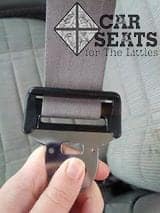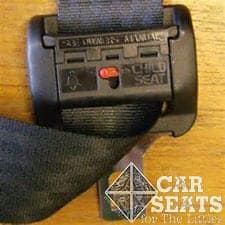Before installing a car seat, the most important step is reading the manuals for both the vehicle and the car seat. The vehicle manual will tell you what kind of seat belts your vehicle has. The car seat manual will tell you what kinds of seat belts the car seat can be used with and if the car seat has any additional locking features of its own.
The following is a basic guide; always read the manual first, and visit a Child Passenger Safety Technician if one is available.
In order to properly install a car seat using the seat belt, the car seat must be tightly installed with less than one inch of movement. To achieve that goal, the seat belt must be locked. There are four ways this can be done:
- Using the seat belt’s latchplate.
- Using the seat belt’s retractor.
- Using a locking clip or belt shortening clip.
- Using a car seat’s built-in lockoff.
Beginning in 1996, all passenger vehicle seatbelts are required to lock pre-crash. This means that seat belts have a locking mechanism in the retractor or in the latchplate. If the vehicle is older than 1996, it may only have an emergency lock, which will require either a locking clip, belt shortening clip, or a car seat lock off to create a pre-crash lock.
Confused? We’re here to help! We’ll explain each kind of belt below.
Latchplates
First, we’ll take a look at all the different types of latchplates that can be found in cars on the road today.
Sliding Latchplate
Sliding latchplates are the most common type; they slide freely along the lap/shoulder belt. If the vehicle is 1996 or newer, most commonly a lap/shoulder belt with this type of latchplate will lock at the retractor (more on that in a minute!). If the vehicle is older than 1996, a locking clip or car seat lockoff can be used with this type of latchplate.
Locking Latchplate (also called Cinching Latchplate)

There are two basic types of locking latchplates. One type is found on lap only belts, the other type is found on lap/shoulder belts.
The locking latchplates may look different from the pictures provided. A lap/shoulder belt with a locking latchplate slides fairly easily before it is buckled, however, once buckled and tightened, the lap portion of the belt will remain locked.
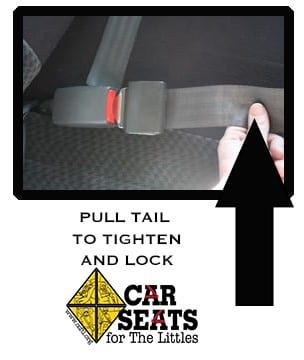
A locking latchplate on a lap belt will lock once the tail is pulled to tighten it.
Switchable Latchplate
Switchable latchplates are not common, and most often appear in older European vehicles. They have a button on the back that must be engaged to switch from regular passenger use to car seat use in order to properly lock the belt for car seat installation.
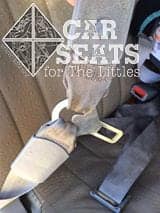
Sewn on latchplate
Sewn-on Latchplate
This type of latchplate is sewn onto the seat belt and may have a lap-only belt or a lap and shoulder belt, as pictured here. Sewn-on latchplates are mainly found in cars built before 1996.
If a sewn-on latchplate does not have a locking retractor, a belt shortening clip must be used. The procedure for use of a belt shortening clip can be tricky, and we would recommend contacting a CPST for assistance if you need to use one.
Now, we’ll look at the different types of retractors.
Emergency Locking Retractor (ELR)
These types of retractors lock in an emergency or a crash. Sometimes you will feel the retractor engage if you slam on your brakes or if you pull on your seat belt hard enough. If you can’t replicate this, don’t panic; sometimes it can be difficult to engage the emergency lock outside of a crash. Check your vehicle manual for information about this function of your seat belts. An emergency locking retractor alone is not enough to install a car seat: the seat belt MUST be locked pre-crash when a car seat is installed.
Automatic Locking Retractor (ALR)
This retractor works just like it sounds: automatically. Pull out any length of the belt and it will remain pre-crash locked at all times.
Switchable Retractor
A switchable retractor is the most common type of retractor. It has an emergency lock and can also be switched to an automatic lock.
To switch modes, pull the seat belt slowly and evenly all the way out to the end. Begin feeding the seat belt back in and you will hear a clicking noise and will not be able to pull out any additional slack. This signals that the seat belt has been switched to the automatic locking mode for car seat installation. Here is a video to illustrate:
Special Circumstances
If your seat belts do not lock via one of the methods described above, you have three options: a locking clip, a belt shortening clip, or a car seat with built-in lock off. This is where car seat installation can be a bit tricky. We’ll explain some of the options for this scenario.
Locking Clip
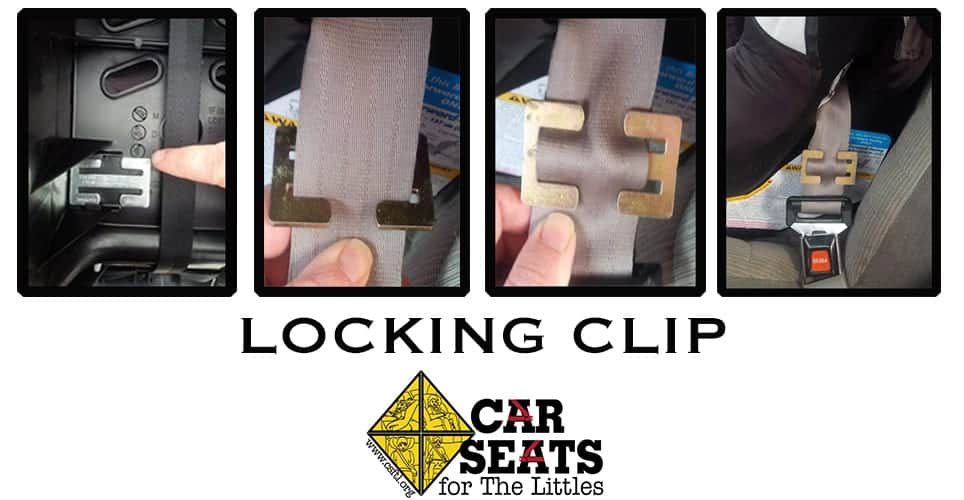
A locking clip can be used on a lap/shoulder belt that has a sliding latchplate and an emergency locking retractor. You cannot use a locking clip on a lap only belt or with a sewn on latchplate.
The locking clip will generally be found somewhere on the car seat itself. Usually, they’re clipped into the shell of the seat on the back somewhere (the exact location varies between manufacturers).
Once you’ve located your locking clip, you’re ready to install the car seat. First, buckle the seat belt and remove all of the slack. Then, carefully unbuckle the seat belt but hold onto the belt to mark how tight it needs to be. Attach the locking clip on the belt no more than an inch from the latchplate and re-buckle the seat.
Belt Shortening Clip
A belt shortening clip looks similar to a locking clip, but is significantly heavier. A belt shortening clip can be used when there is a lap belt with a sewn on latchplate that has an emergency locking retractor. The belt shortening clip must be purchased from the vehicle manufacturer, it does not come with the car seat and a locking clip may NOT be used as a substitute. This is not common, and can be difficult to do properly so we recommend contacting a CPST if you think your vehicle may require a belt shortening clip.
Lockoff
Some car seats have a lockoff built into the seat itself to provide a pre-crash lock. These can generally be used on vehicles that have a lap/shoulder belt with an emergency locking retractor. Always refer to the car seat manual for proper use guidelines; they come in many shapes and sizes and each has their own specific rules. These seats include, but are not limited to: Combi Coccoro, Clek Foonf, and the Chicco KeyFit and Nextfit. The Click Tight feature on the new generation Britax seats function as lockoffs as well.
When installing a car seat, whether it’s for the first or the 41st time, remember to check those manuals before you begin. If you are unsure about any part of your car seat installation (or even if you are sure, it doesn’t hurt to double-check!), please find a CPST near you.

